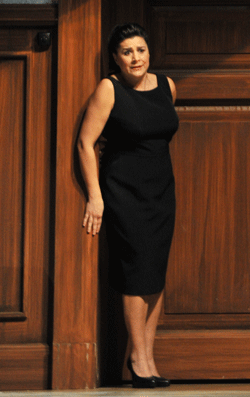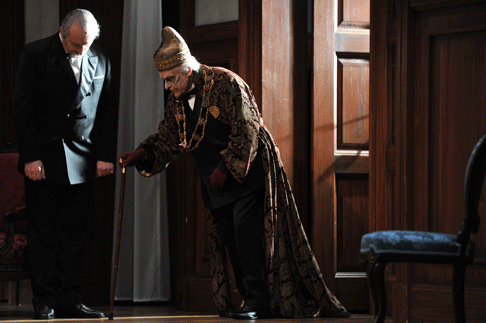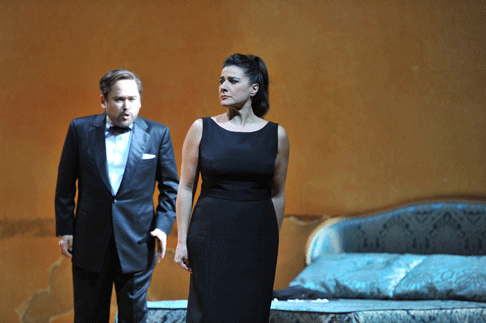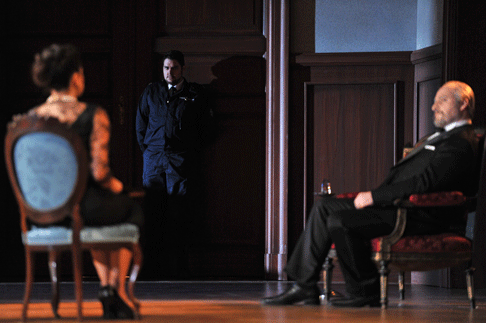Way, way out.
The reasons for this unqualified success are many, beginning with superb
casting that no house could better.
 Cecilia Bartoli as Desdemona
Cecilia Bartoli as Desdemona
As Desdemona, Cecilia Bartoli remains at the top of her game. This was my
first live experience with La Bartoli in a dramatic role, and well, to frame
the experience in a highly complicated, technical way: she sang the living snot
out of it. There seemed nothing Cecilia couldn’t do. Her throbbing soprano
summoned forth a gutsy fury one moment, and the next could spin out a
pianissississimo so achingly delicate we scarce could breathe. The impeccable
vocal fireworks we have come to expect were securely on display to be sure, but
this night there was less aspiration on the runs and roulades with no loss of
color or accuracy. Her unflinching, fierce commitment and her consummate
musical imagination were always in evidence, constantly imbued with an
unforced, innate musicality.
Since Signora B had considered every dramatic variant possible in the role,
she took us on a richly complicated dramatic journey. Along the way, our Diva
gave us a searing finish to Act II as she held the penultimate high note with
pointed conviction and incredible duration. A short while later, her Willow
Song was a master’s class in meticulously crafted, tonally limp,
beautifully judged pathos. Our star has made a happy marriage indeed between
her medium-sized voice and this jewel of a medium sized house. She performs
staged opera most often here, and her public clearly adores her. And why not?
With her immensely satisfying catalogue of recordings, her highly personal
performing style, and her glamorous persona, there is no international star
bigger than Cecilia Bartoli, and damn’ few her equal.
She was splendidly matched with her Otello, John Osborn. He had paired very
ably with her in 2010’s Clari but nothing in that lighter piece
showed off his awesome skill set. For Mr. Osborn boasts an usually wide range
of tessitura, from the expected ‘very high’ to the unexpected ‘very low
indeed.’ The richness, responsiveness and directness of his burnished tenor
are a joy; and the precision and meaningfulness of his florid singing are not
normally expected from a voice of such generous amplitude. Our Moor took the
role by storm (as it were) with a potent, bravura vocal display. Moreover, John
and Cecilia worked musical magic together, blending seamlessly as their world
class instruments intertwined in the extended duet. (A handful of the tenor’s
phrases in middle voice were colored with a slightly grainy cast that recalled
James McCracken, a bygone — albeit entirely different — Moor.)
One of the stellar singers on the Zurich house roster, Javier Camarena
(Rodrigo) summoned forth a marvelous blend of honeyed tone and technical razzle
dazzle. Mr. Camerena’s even, secure, warm lyric tenor brought pleasure all
evening, and we got the added bonus of the producers assimilating the final
cameo of Lucio into his role, giving this talented performer a final scene to
steal. Young Edgardo Rocha has grown enormously since I heard him last November
in Wexford. His tenor rang out with Èlan, and his gleaming, bright sound was
all the more effective for its confounding our concept of the usual dark voice
types we imagine for Iago. Mr. Rocha’s singing was bright, lean and mean, and
effectively insinuating. He and Javier conspired to ravish us with a zinger of
a duet that fairly crackled with intensity, and reveled in pyrotechnic
coloratura displays.
 Peter K·lm·n as Elmiro and Nicola Pamio as the Doge
Peter K·lm·n as Elmiro and Nicola Pamio as the Doge
In the smaller role of Emilia, Liliana Nikiteanu was a beautiful vocal
presence. Her somewhat cooler, reasoned, haunting mezzo provided a good
balance, and the two ladies manufactured a seamless blend on the plaintive
duets. Peter K·lm·n showed off an ample, searing bass as an authoritarian
Elmiro, sounding as imposing as many a Don Carlo Filippo. Nicola Pamio
created a visually senile and doddering, though vocally solid, Doge. Young
Artist Ilker Arcay¸rek’s lovely off-stage tenor brought a mellifluous
serenity to the Gondolier’s arietta, so lovely it made us wish for more.
These outstanding soloists were matched in excellence note for note from the
pit, populated by the nonpareil ensemble “Orchestra La Scintilla” of the
Zurich Opera. Of course, such Early Music evenings begin as they must. They
tuned and tuned. And tuned. And then tuned. But then this period instrument
band tore into this infrequently heard opus as though it were a masterpiece
deserving of their finest efforts. Conductor Muhai Tang was a revelation as he
elicited unstinting, dramatically informed playing from his instrumentalists.
Maestro Tang brought to bear notably fine pacing and exquisite attention to
color and detail. He accommodated the soloists effectively, breathing with
them, urging them on one minute, indulging them in elastic phrasing the next.
The reading was driving yet highly responsive, a consummately controlled
performance. While the entire band was magnificent, there was standout
partnering from the solo horn (Glen Borling) and clarinet (Robert Pickup) who
assumed real personalities as they helped underline the psychological state of
the singers.
 Javier Camarena as Rodrigo and Cecilia Bartoli as Desdemona
Javier Camarena as Rodrigo and Cecilia Bartoli as Desdemona
No less engaging was the well-considered physical production (set design by
Christian Fenouillat). At opening, Otello was being celebrated at a formal
indoor ceremony in a huge, late 19th century drawing room, cool blue with
oversize oak doors. Up stage left, very tall double doors open (and close) to a
formal dining room where the guests retire after the opening chorus. A huge
white Murano glass chandelier dominates the room, the only other furnishings a
deep blue damask settee up center, and matching chairs down left. A large
window, left, afforded wonderful lighting effects from designers Hans-Rudolf
Kunz and Christophe Forey. The duo suffused the room with a warm orangey
sunlight which later morphed to a harsher cross-lighting that made the ominous
faces of the lined up chorus visually ‘pop’.
Agostino Cavalca’s clean, modern day costumes also serve the concept well,
the chorus in suits and formal wear, Otello in dress blues (later in military
work clothes like Iago’s), the Doge in religious drag. Ms. Bartoli looked
fetching in a simple black cocktail dress, to which fitted lace sleeves and a
pearl necklace were added to good effect. Emilia appeared to be a social
secretary, business casual in slacks and a draping gray silk knit top.
Desdemona sheds the dress, to end the night in a satiny white slip. Simple.
Effective. Each costume told us who the character was.
Desdemona’s bedroom was a vibrant burnt orange, furnished only with a
double bed up left and a settee just inside the door stage right, both again
blue damask. The other setting was the servants’ cantina, with violently
green colored walls, mismatched furniture, a pool table with chairs upended
upon it, and two large cold metal doors up right that open onto the street.
Within these re-imagined locales, directors Moshe Leiser and Patrice Caurier
crafted a persuasive case not only for their vision, but also for Rossini’s
drama.
 Cecilia Bartoli as Desdemona, Edgardo Rocha as Iago and Peter K·lm·n as Elmiro
Cecilia Bartoli as Desdemona, Edgardo Rocha as Iago and Peter K·lm·n as Elmiro
They accomplished this with unfussy, fluid blocking that placed singers in
advantageous stage positions to be able to be seen and heard. (It sounds simple
but you have no idea how often that is not the case in Euro-Concept
productions.) Next, they kept their singers tightly focused on each other,
exploring the dramatic truth that was the underpinning for the need to sing
their emotions in the first place. Next, they knew when to get their performers
into an effective picture and then stay relatively still, allowing them to sing
complicated ensembles (like the fiendishly difficult sextet) to maximum effect.
And finally, they contrived just enough unique business to inject a bit of
edginess into the proceedings. A few examples:
The thinly disguised racism of the court is pointed up by having a pair of
servants appear at the dining room doors with trays of food. The white server
is allowed in with his tray, the black server is relieved of his and turned
back to the kitchen. When he reappears with a coffee service, it is knocked out
of his hands as Elmiro storms through the doors from the dinner. His seething
look withers the poor servant into an apologetic mopping up of the mess.
In Two, Otello is presented hanging out drinking beer in the servants’
recreation area, underlining his social status. At that act’s end, as Elmiro
discredits his daughter, Desdemona, barefoot now (trapped down left between the
pool table, the refrigerator, and the Deep Blue Sea) deliberately and
oh-so-slowly reaches into the fridge and pulls out…a beer with which she
sarcastically toasts her father. She plays the scene a bit unhinged which works
sensationally well, climaxing with a crawl up to stand on the pool table. As
she towers over dad, screaming the afore-mentioned searing high note at him,
she dementedly pours the beer all over herself. Nuts. Brilliant. Meaningful.
They all scramble to grab her down to stop her making a display of the family
business in front of the servants.
In the final act, a resplendent treatment of the Willow Song began
with Desdemona hauling out an old phonograph from under her bad. She knelt and
placed it downstage in silence, lifted and set the needle, and the tune began
to play through the speakers. Julie Palloc’s wonderful recorded harp-playing
was a little LP-scratchy at first, but as the live orchestra snuck in when
Bartoli began singing, we had experienced a luminous effect indeed. The final
visual coup: after Otello had stabbed Desdemona and she lay bloodied and
lifeless against the back wall, the stage right wall (with locked door) tracked
toward center creating a split stage. On the outside were the (now) forgiving,
conciliatory forces, while in the bedroom our trapped hero careened helplessly,
unlocking the door and stabbing himself just as the optimistic court flooded
in. As Elmiro and Rodrigo came upon Desdemona’s corpse, they found an outlet
for their shock and grief by kicking the Moor’s crumpled body, reminding us
of the racism that had, after all, started the plot’s inexorable descent into
tragedy.
To sum up: If this thrilling evening in the opera house was not theatrical
and musical perfection, well, then I don’t know what is.
James Sohre
image=http://www.operatoday.com/Otello_Zurich_01.gif
image_description=John Osborn as Otello [Photo by Hans Jˆrg Michel courtesy of Opernhaus Z¸rich]
product=yes
product_title=Gioachino Rossini: Otello
product_by=Otello: John Osborn; Desdemona: Cecilia Bartoli; Elmiro: Peter K·lm·n; Rodrigo: Javier Camarena; Iago: Edgardo Rocha; Emilia: Liliana Nikiteanu; Lucio: Javier Camarena; Doge: Nicola Pamio; Gondolier: Ilker Arcay¸rek; Conductor: Muhai Tang; Director: Moshe Leiser, Patrice Caurier; Set Design: Christian Fenouillat; Costume Design: Agostino Cavalca; Lighting Design: Hans-Rudolf Kunz, Christophe Forey; Chorus Master: J¸rg H‰mmerli.
product_id=Above: John Osborn as Otello
Photos by Hans Jˆrg Michel courtesy of Opernhaus Z¸rich